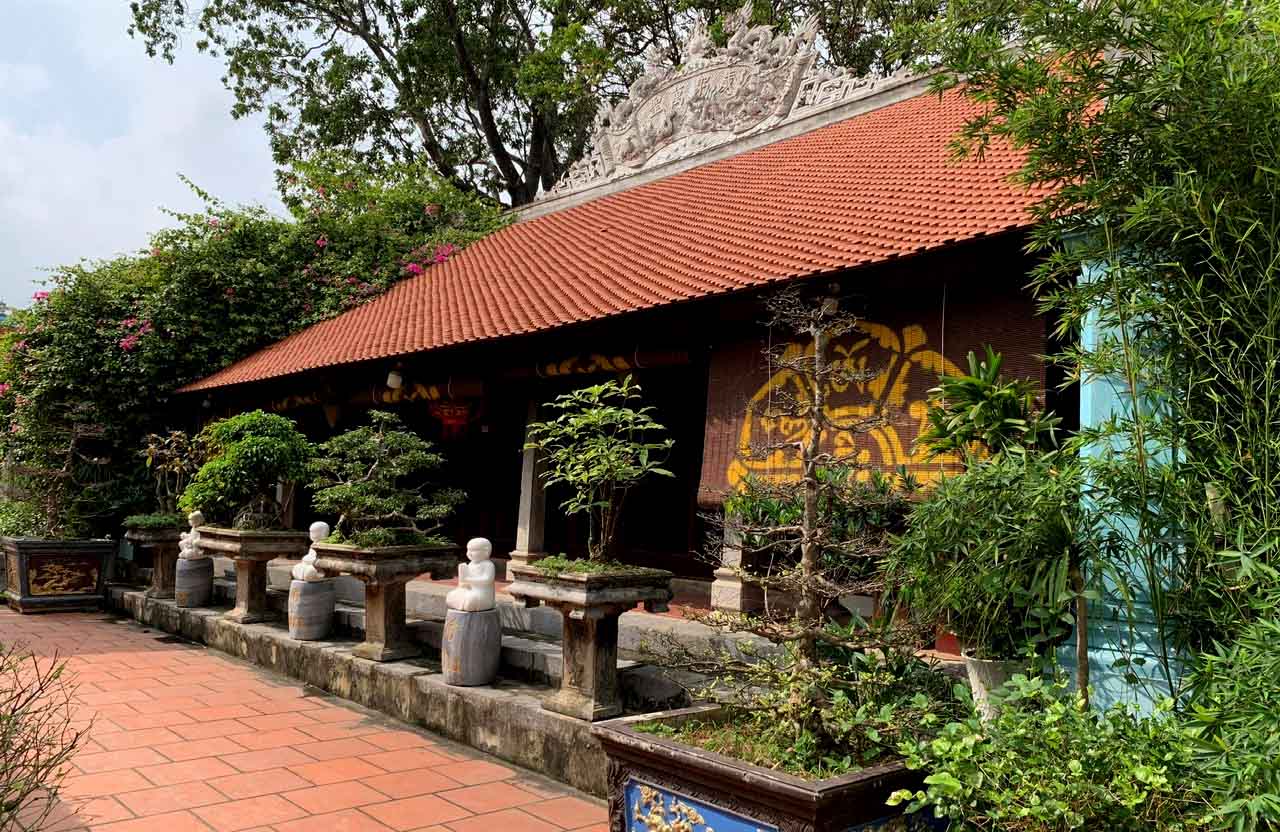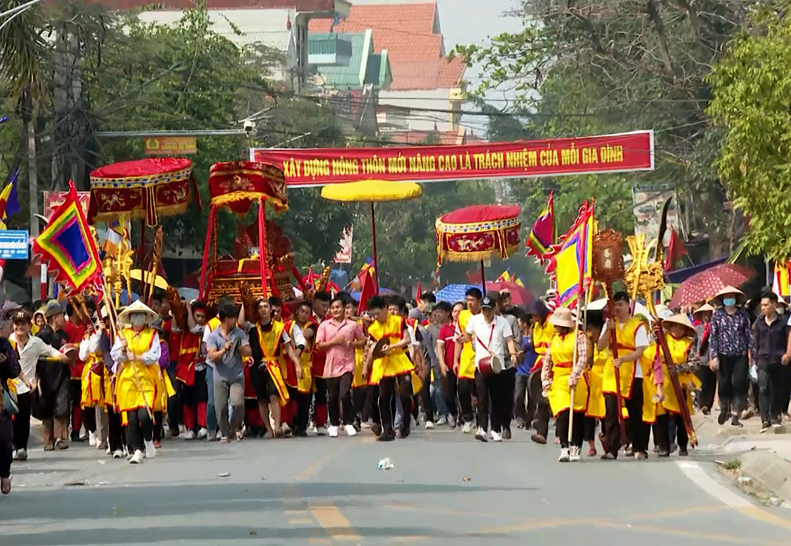Dau Pagoda is an ancient pagoda, located in Chua hamlet, Khanh Hoa commune, Yen Khanh district, Ninh Binh province. Established during the reign of King Ly Thai Tong, however, the pagoda bears the mark of the architectural style of the Tran dynasty. The south facing pagoda which is situated on a 5,000 square meter land lot was recognized as a national historical and cultural relic.
Its Vietnamese ancient name was 靈衙寺 / 灵衙寺 / Linh Nha tự also known as Phủ Dầu. A pair of calligraphy couplets hang on the three – entrance gate indicates the role of Dau Pagoda under 2 dynasties of Ly and Tran
李朝而起陳朝而興萬古名藍
天柱已維地軸已立天年勝跡
Rendered as:
“The Ly dynasty established, the Tran dynasty thrived, this pagoda evermore
The pillars of heaven are sturdy, the axis of the earth is sustainable, forever that scene”

According to Southern History Early Edition and Thai Vi Royal Family Tree, during the second invasion of the Yuan - Mongol (1285), having to encounter the dominant strength of the enemy, King Tran Thanh Tong resorted to dispatch the Royal Court and his army to Truong Yen, Ninh Binh in order to establish a military base to resist the enemy and save the country. Prince Ngu Cau Vuong obeyed his father's order to bring troops to guard the Ma Lang area (the present day area of Dau Pagoda, Khanh Hoa commune). This coastal area is approximately 10km south of Truong Yen military base as the crow flies. The prince established a quite solid fortress here. One year after the second war against the Yuan-Mongol army (1285), Princess Huyen Tu came here to visit her younger brother, Prince Ngu Cau Vuong, and to console the soldiers. Falling in love with the beautiful scenery of Dau Pagoda, the princess asked the king to allow her to be ordained as a Buddhist in the pagoda. King Tran Thanh Tong granted the princess 173 acres of fields as a donation for the pagoda. She renovated and expanded Dau Pagoda, and built the road leading into the pagoda in the shape of a winding dragon, making it the main road of Yen Ve district. Since then, Dau Pagoda has become famous throughout the region. Monks, nuns, and Buddhists from across the country came to worship Buddha at Dau Pagoda. They came not only to worship Buddha, but also to meet and visit the princess and prince. Later, people worshiped the prince and princess at Dau Pagoda.
Dau Pagoda was established on high ground, facing southwest. The pagoda worships Buddha at the front and Deities at the behind).
Entering from the southwest are 3 main doors, passing through the brick yard to reach the front hall with 7 tall compartments, and rafters. The relief paintings are carved with dragon, ly (fantasy animal), tortoise, and phoenix (four sacred animals). Only the middle compartments is wide with a door, the remaining 4 compartments on both sides are built with walls, and the last 2 compartments with both gables have small doors. In the front hall, there are two tall statues of the Dharma Protector sitting on a crocodile (more than 3 meters high) that look colossal and the statues of Duc Ong (on the right) and Duc Thanh Hien (on the left). Connected to the front hall is the central hall.
Behind the central hall is the 3-compartment temple, with 2 narrower compartments on the sides. The unique thing about the hind temple is that the middle compartment has a rectangular stone of Tran Dynasty lotus pedestal, more than 3 meters long, 1.5 meters wide, 1 meter high. This is a unique stone pedestal, the border is large lotus petals, carved in a concave and convex style, with seals and soft patterns on 3 sides. On the stone pedestal are three statues of Tam The. On the right wall there is a statue of the Queen Mother of the Tran Dynasty, and on the left wall there is a statue of the King Father of the Tran Dynasty.
Dau Pagoda is a relatively large relic area, currently retaining some precious relics of the Tran and Later Le dynasties such as lotus stone pedestals and Dien Thanh stele, while the rest of the building carries architectural elements of the recent Nguyen dynasty. Up to now, Dau Pagoda has undergone many restorations and embellishments to promote the value of the monument, contributing to preserving a valuable heritage in the nation's history, educating the tradition of loving one's homeland and country. , at the same time serving the needs of tourism and improving the cultural and spiritual life of the people.
Every 3 years, Dau Pagoda holds a big festival in the years of: Rat, Horse, Cat, and Rooster. This festival lasts three days and three nights on the commemoration of Princess Huyen Tu's death - February 29 (lunar calendar) (due to the lack of February in the lunar calendar, it is called the 30th day). Every year, the Thai Vi temple festival (belonging to the Tam Coc - Bich Dong tourist area) takes place from the 14th to the 16th day of the third lunar month to commemorate the merits of the Tran kings who came here to establish the Vu Lam palace as At the rear of the resistance war against the Mongols, the people of Khanh Hoa commune also brought palanquins there to attend the festival

Thai Vi temple festival is the general village festival. Because these villages all worship Tran kings and Tran dynasty generals. Right from the afternoon of March 14, the villagers of Van Lam opened the gate of the temple and took the holy incense bowl to the communal house. Legend has it that in the past, this was the place where mandarins went to report before entering the Vu Lam palace to have an audience with King Tran. On the morning of March 15, the villages of the ancient Vu Lam commune would carry palanquins of their village's saints to Cac Communal House for worship. First, Khe Dau (upper and lower) village, the eldest - brother - village, will carry the holy palanquin through the villages: Xuan Ang, Kha Luong, Hanh Cung, Ha Trao, Tuan Cao. To each village, the palanquin followed. Both Dau Pagoda (Khanh Hoa, Yen Khanh) worshiping Prince Ngu Cau Vuong and Princess Huyen Tran of the Tran Dynasty were also brought here. Besides, the Great Gathering is held only once every 60 years, lasting for 5 days and nights at Dau Pagoda, which is truly rare and "unique", only Dau Pagoda has it. That is the uniqueness of Dau Pagoda. This traditional cultural beauty is being preserved and promoted as the national cultural identity meets the daily needs of the people.